Deryck Kanhai, the miner who took the lives of four persons on Tuesday before he was killed during a shoot-out with police was in the bottom flat of his building for the duration of the standoff and did not have access to his CCTV camera monitors as previously thought.
Kanhai, who hailed from Karrau, Region Seven was the owner of several dredges and he was in the process of constructing a hotel in Bartica.
On Tuesday, Kanhai single-handedly held dozens of police officers at bay from his 315 Middle Street home for more than two hours after he went on a rampage, killing civilians Vanessa Williams and Hugh Rowland. Lance Corporal Michael Forde and Constable Sherwin Pantlitz of the Guyana Police Force (GPF) were the other two persons who lost their lives during the ordeal
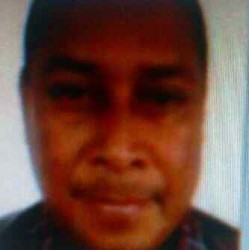
Williams was a despatcher at the Crown Cabs Taxi Service, which operated from the western-most section of Kanhai’s three-storey building, while Rowland was a resident of the area who frequented Kanhai’s premises. Kanhai also wounded a taxi driver from the service, a man identified as Paul Raman. The berserk miner then took to the streets, randomly discharging his weapons at intervals.
An eyewitness who was in Da Silva’s Optical when Kanhai started his shooting spree said that she saw him running up Middle Street, to the point where it intersected with East Street, where he fired off several more rounds. The witness, who was among several persons who barred themselves in the Optical centre which sits obliquely opposite Kanhai’s building, said that he was holding a shotgun in his hands, and was also in possession of a handgun (which was in his pants waist.
Eventually the man’s actions attracted the attention of the police, who continued to come in droves until more than seventy officers from several of the Force’s departments, were engaged in the operation. By the time the police arrived, Kanhai had insulated himself in his building and so the police ranks surrounded it. The yards, buildings and even the stairs of the nearby buildings were teeming with police ranks as they formed an air-tight “net” around Kanhai’s premises.
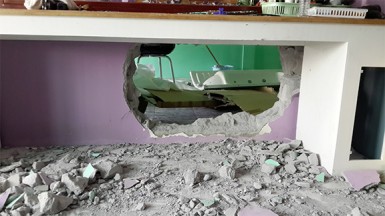
The problem though, was that the police officers did not seem to know where in the house Kanhai was hiding, even as he repulsed numerous of the police’s sorties to breach the building and get to him. Both police officers who died in the exchange are alleged to have been killed while attempting to enter the building. According to a witness, Pantliz, who came to the scene without exercising caution, tried to move in on Kanhai as if he was “immortal. Sadly, that was the end of him”, she said. Blood stains were found just inside a salon which operated at the bottom of Kanhai’s residence and Stabroek News was informed this might have been where he was shot.
A woman who was inside when Kanhai fired his first shot said that she thought that bandits were coming to rob him. When she heard the shots, the woman told Stabroek News, she ran for cover behind a wooden wall, but she said that she quickly realised that the wooden wall might not be sufficient and so sought refuge in a concrete washroom.
While in the washroom, she said, she peered through a back window and saw Kanhai with his guns. She said that the man looked at her asked her, “Is where they deh! Is where they deh!” She said that she thought he was referring to the bandits, but said that after she noticed the “crazy look on his face and his red demon-like eyes,” she bolted from the building all the way to the Balwant Singh Hospital.
Forde was shot not too far from the entrance from the salon. From where he was standing it is unclear how he came to be shot from that angle.
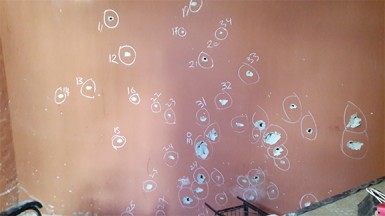
Kanhai was defending his makeshift fortress so effectively that the police assumed that he was using his CCTV cameras to monitor the movement of the police from the control room, which is on the second floor of the building.
Kanhai had cameras at several locations on his house, and in most of the places that police ranks had taken up positions. As such; the police began shooting and otherwise destroying as many cameras as they could locate in an effort to remove Kanhai’s supposed advantage.
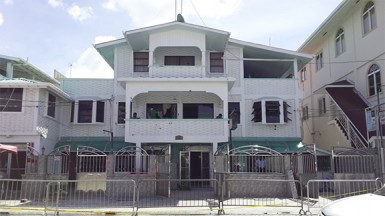
But yesterday Stabroek News was told that Kanhai was in the bottom flat of the building throughout the ordeal and did not have the benefit of his cameras. The man’s brother, Aubrey Kanhai, yesterday revealed that it has been determined that Kanhai engaged the police from a bottom flat compartment which housed a salon, and was completely cut off from the rest of the building. Aubrey therefore expressed his curiosity to this newspaper yesterday and said that he was at a loss as to why the police and the media thought his brother was using the cameras to keep tabs on the police’s movements.
Gunshots directed to all four corners of the lower, middle and upper flat of Kanhai’s building, in addition to the attempts to destroy his cameras, are testament to the fact that the police force were not sure where he was operating from. Aubrey said as much on Tuesday, when he told reporters that the police had admitted to him that they did not know where Kanhai was shooting from.
This may explain why, more than two hours into a gunfight with one man, police were unable to subdue him. Eventually though, the police figured out that Kanhai was hiding out in the salon and started concentrating their attention on the bottom flat.
The bottom flat of the building has five entrances, all facing Middle Street, which avails access to various rooms. The eastern-most door gives access to a stairway which leads to
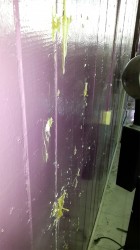
the second flat while the door just after that one leads to an unoccupied apartment. After the apartment is the salon, where Kanhai retreated and stayed after police began to arrive at the scene.
Just after the door which gives access to the salon, is another door which gives access to the second floor of the building, and after that is the final door, the western-most door, which leads to the Crown Cabs base.
When Stabroek News revisited the scene of the incident yesterday it was determined that the space in which the salon was operated was completely cut off from the rest of the building, meaning that he was, in fact, unable to get upstairs to view what was happening on his CCTV system.
After finally determining that Kanhai was in the salon, the police began concentrating all of their resources on the man’s location.
Stabroek News yesterday learned that the police used a sledgehammer to smash a hole through which they accessed the empty apartment. They then sledged a hole in the wall which separated the apartment from the salon, in which Kanhai was hiding out. From this hole they would have been able to fire shots at Kanhai.
An inspection of the inside of the salon revealed that there were bullet holes in the salon’s western wall. The nature of the bullet holes left in the wall led to the conclusion that police ranks had gone through the western door which gives access to the second floor, and began shooting blindly through the walls in the hope of hitting Kanahi.
Thick bloodstains and splatter in the Facials Room of the salon led to the conclusion that this might have been the spot where Kanhai, whether at his own hands, or that of the police was fatally shot. The room itself bore scores of bullet holes. The nature of several of the holes on the room’s western wall indicated that Kanhai had been trying to shoot through the walls at ranks. A window, to the eastern side of the room was broken, and it is believed Kanhai used this window to push back ranks advancing on the building from behind.
There were also pellet holes in the room’s northern walls, but these holes are thought to have been caused by shotgun pellets shot through a wall.
On Tuesday, for several hours Kanhai’s building and its surroundings were in a state of pandemonium as Kanhai and the police faced off. Brazen on-lookers braved the risk of being shot and police warnings to get a glimpse of what was going on even as a GDF helicopter flew over the scene, presumably to provide aerial assistance.
As the police resorted to the use of tear gas to flush Kanhai out of his building, the effect the gas was having on the nearby Balwant Singh Hospital and several schools forced the police to discontinue this tactic. An eyewitness said that the ordeal started just after two, but Kanhai was only killed around 16:30. As Kanhai fended off the police force for several hours with three weapons and a seemingly infinite amount of ammunition, on-lookers were heard screaming chants of approval every time he challenged the gunfire of the police with his own.
Meanwhile, Paul Raman, the taxi driver injured in the shooting, up to yesterday remained in a stable condition at the High Dependency Unit of the Georgetown Hospital. He was shot to his abdomen twice.
What triggered Kanhai’s behaviour is still to be determined, although there have been several suggestions. Police Commissioner Leroy Brumell has said that police investigators have been told that Kanhai began behaving strangely a few days ago after he had an issue with a female. This, Brumell said, is believed by the police, to have led to Tuesday’s incident. Also, his daughter in law told Stabroek News that he thought persons had planted cameras in his home and were watching him. He had reportedly torn out a section of his ceiling and a mattress in search of these cameras.





